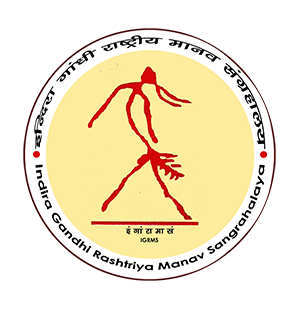नेकमोंग (गारो जनजाति का पारंपरिक आवास)
जिला: वेस्ट गारो हिल्स, मेघालय
संकलन वर्ष : 2012
गारो जनजाति मेघालय की तीन मूल जनजातियों में से एक है। वे असम, त्रिपुरा, नागालैंड और बांग्लादेश के कुछ क्षेत्रों में भी छिटपुट रूप से बसते हैं। गारो नाम उन्हें गेर गाये पड़ोसी लोगों द्वारा दिया गया है। मातृवंशीय परंपरा के लिए प्रसिद्ध गारो परिवारों के वंशज अपनी माता के बंश नाम से जाने जाते हैं। परंपरागत रूप से, सबसे छोटी बेटी (नोकमेचिक) को मां की संपत्ति विरासत में मिलती है। बेटे युवावस्था में माता-पिता का घर छोड़ देते हैं और गांव के छात्रावास (नोकपंते) में प्रशिक्षित होते हैं। शादी के बाद पति पत्नी के घर पर रहता है। गारो अब मेघालय राज्य की दूसरी सबसे बड़ी जनजाति है और राज्य की कुल आबादी में एक तिहाई गारो शामिल है।
जब हम गारो गांवों के आवास और उनके बंदोबस्त को देखते हैं, तो पहाड़ी ढलानों पर छितरे हुए आवास दिखते हैं, जो बांस और लकड़ी की संरचनाओं वाले खम्बो पर बने हुए होते हैं । इन घरो पर स्थानीय घास से छाजन कर सुव्यवस्थि तरीके से छप्पर डाला जाता है। परंपरागत रूप से, मेघालय की गारो जनजाति के बीच चार प्रकार की स्थानीय वास्तुकला देखी जा सकती है। इन घरों को, जनजाति लोगों जीविका पालन के तरीको एवं सामाजिक-आर्थिक दायित्वों के अनुसार वर्गीकृत किया जाता है। ये पारंपरिक बांस-प्रधान आवासीय हैं; 1) नोकमोंग (एक सामान्य रिहायशी आवास), 2) नोकपंते (लड़कों का छात्रावास या युवागृह), और बोरंग (फील्ड हाउस/ट्रीहाउस/ वॉचटावर)। घर आम तौर पर लकड़ी, बांस, बेंत और फूस जैसी प्राकृतिक रूप से उपलब्ध निर्माण सामग्री के उपयोग से बनाये जाते हैं।
’नोकमोंग’ एक ऐसा घर है जहां परिवार के सभी सदस्य एक साथ रहते हैं। घर में सोने की जगह, चूल्हा, रसोई, जल भंडारण की व्यवस्था, शराब, मवेशियों के लिये शेड, गायों के लिये भूंसा, सुअर, मुर्गी पालन इत्यादि के साथ जलाऊ लकड़ी के लिए बाड़े का प्रावधान भी होता है। घरों का सुन्दर और सुव्यवस्थित होना ही वह वजह है जिससे गारो मातृवंशीय परिवार घरेलू गतिविधियों में अच्छी तरह से संगठित प्रतीत होता है। घर आम तौर पर पहाड़ी ढलान की समतल जमीन पर बांस एवं लकड़ी के उपयोग से विशिष्ट आकार और सुन्दर संरचनाओं का निर्माण कर बनाया जाता है। इस बांस के चबूतरे का ऊपरी भाग पर्याप्त रूप से आपस में गुंथे हुए बांस के फर्श से ढका हुआ होता है जो रहने की जगह के रूप में उपयोग किया जाता है। फर्श के तीन भाग हैं, दो बगल में जबकि एक पीछे के छोर पर है। बाएं भाग का उपयोग कई गतिविधियों के लिए किया जाता है जैसे फुरसत के क्षणों को बिताने, टोकरियाँ तैयार करने, कटे हुए कंद, मीट, मिर्च आदि को सुखाना। दायाँ भाग मुख्य रूप से बर्तन, कपड़े धोने और अन्य सहायक घरेलू गतिविधियों के लिए है।
घर के सामने की जगह जमीन से लगी हुई (बाड़े नुमा) होती है, और यह पालतू जानवरों के लिये होती है। परंपरागत रूप से, सुअर, गाय या बैल की सबसे मूल्यवान नस्ल को परिवार की संपत्ति के रूप में इस बाड़े में सुरक्षित रखा जाता है। जमीन पर लंबवत रूप से टिका हुआ लगभग डेढ़ फीट का एक विशाल गोलाकार लकड़ी का लट्ठा घर के प्रवेश द्वार का प्रतीक है। प्रवेश द्वार में एक स्लाइडिंग दरवाजा है, जिसे बांस की पिंचियों की चटाई से तैयार किया गया है, जो बांस के स्लाइडिंग फ्रेम पर लटका हुआ है।
बीच का कमरा सबसे महत्वपूर्ण कमरा होने के कारण तुलनात्मक रूप से सभी कमरों से बड़ा है जो स्थानीय रूप से ’डोंगरामा’ अथवा लिविंग रूम के रूप में जाना जाता है। इस बड़े कमरे के बीच में आग जलाने की जगह भी है, जिसे ’ओंगर’ कहा जाता है, जिसे ऊपर उठे मिट्टी के चबूतरे पर बनाया गया है। ’ओंगर’ के ऊपर समतल बांस से बनी मचान नुमा संरचना को लटका कर रखा जाता है जहॉं टोकरियों और आगे उपयोग में आने वाले खाद्य पदार्थों को रखा जाता है।
गारो घर के अंदर एक रसोई घर है, और दीवार जो पीछे के भाग को अलग करती है जो घरेलू देवता का स्थान है। घर के इस स्थान में महत्वपूर्ण घरेलू अनुष्ठान किए जाते हैं। इस दीवार पर घरेलू देवता की पूजा से जुड़ी अनुष्ठान सामग्री और अन्य प्रतीकात्मक सामग्री भी देखी जा सकती है।
घर के बाहर, बगल में बने चबूतरों का उदेशीय महत्व है जिनकी संख्या अक्सर दो अथवा तीन होती हैं । यह एक उठा हुआ चबूतरा है जिसका उपयोग फुरसत के क्षणों को बिताने एवं अनाज सुखाने और अन्य प्रकार के घरेलू उपयोग के लिए किया जाता है। दांईं ओर की जगह विशेष रूप से उस अतिथि के लिए है जो उनसे मिलने आता है।
बदलते समय के साथ, आधुनिक जीवन शैली धीरे-धीरे पारंपरिक जीवन शैली में प्रवेश करने लगी है। गारो जनजाति की बहुमुखी बांस-प्रभुत्व वाली दशाज वास्तुकला अब आधुनिक जीवन शैली के अनुरूप बदल रही है । यह वास्तुकला दुर्लभ है जो केवल मेघालय में गारो आवास वाले दूरदराज के गांवों में ही देखी जा सकती है। इंगांरामासं ने अपनी मुक्ताकाश प्रदर्शनी में प्रदर्शित इस समुदाय के पारंपरिक आवास प्रकार को संरक्षित किया है । संग्रहालय का उद्देश्य इस जनजाति की गौरवशाली संस्कृति को जन-जन तक पहुंचा है।
Nokmong (Garo House of Meghalaya)
Dist: West Garo Hills, Meghalaya
Year of Collection: 2012
The Garos are one of three native tribes of Meghalaya. They are also sporadically distributed in Assam, Tripura, Nagaland, and some areas of Bangladesh. The name Garo has been given to them by the neighboring people, who are the non-Garos. A very well-known tribe for their matrilineal tradition and the heir of the families take their clan titles from their mothers. Traditionally, the youngest daughter (nokmechik) inherits the property of the mother. Sons leave the parents’ house at puberty and are trained in the village dormitory (nokpante). After getting married, the man lives in his wife’s house. Garos are now the second-largest tribe in the state and comprised one-third of the local population. 1
When we look at the habitat and settlement pattern of the Garo villages, one may find sparsely arranged, bamboo-dominated house types raised on stilts of bamboo and wooden poles having nicely trimmed thatch structures along the ridges of hill slopes. Traditionally, four types of vernacular architecture could be seen among the Garo tribe of Meghalaya. These houses are classified according to the livelihood patterns, socio-economic liabilities of the tribe. These traditional bamboo-dominated house structures are; 1) Nokmong (a common living house), 2) Nokpante (Boy’s Dormitory), and Borang (Field house/ treehouse/ watchtower). They normally use naturally available building materials like timbers, bamboo, cane, and thatch.
Nokmong is a house where every A’chik(family members) stays together. The house has the provisions for sleeping, hearth, sanitary arrangements, kitchen, water storage, fermenting wine, a place for cattle-shed or stall-feeding the cow, pigsty, hencoop, and enclosure for stacking firewood. These neatly arranged space of the house perhaps is why the Garo matrilineal family appears to be well organized in domestic activities. The house is typically erected through a stilted bamboo structure and local wood along the hill slope to obtain a plain platform above the ground. The top of this bamboo platform is adequately covered with a matted bamboo floor and used as a living space. There are three extensions on the floor plan, two along the sides while one at the rear end. The left extension is used for multiple activities like spending leisure, preparing baskets, drying sliced tubers, meats, chilies, etc., while the right extension is primarily meant for washing utensils, clothes, and other auxiliary domestic activities.
The front space of the house touches the ground, and it occupies a space for the domestication of animals. Traditionally, the most valued breed of either Pig, Cow, or a Bull is kept reserved in this enclosure as the family’s wealth. A massive circular log of about one and a half feet rested vertically on the ground is marks the entrance of the house. The entrance has a sliding door prepared from a bamboo-splitted mat hanging on a sliding frame of bamboo tube.
The central hall being the most important room, is comparatively bigger and locally known as Dongrama or a living room. This big hall also has a central fireplace called Ongar, raised out of a mud plinth. The hanging platform of bamboo in layers is placed above this fireplace to stack food items and baskets for more prolonged use.
Garo house has a kitchen inside, and the wall that separates the rear extension is a place of the domestic deity. Important rituals of domestic affairs are conducted in this space of the house. Ritual items and other symbolic paraphernalia associated with the worship of domestic deity could be seen on this wall. Two or three outwardly extended pile structure from the side of the house has multifunctional importance. It is a raised platform sometimes used to spend leisures and drying grains and other kinds of household utilities. The right side extension is specially meant for the guest who visits them.
With the changing time, modern livelihood has gradually started to enter into the traditional way of living. The versatile bamboo-dominated vernacular architecture of the Garo tribe is now transforming to tune with the modern way of living. It becomes scarce and could only be in the remote villages of the Garo habitat in Meghalaya. IGRMS has preserved this traditional house type exhibited in its Open Air Exhibition and aims to disseminates the glorious culture of the tribe to the masses.



